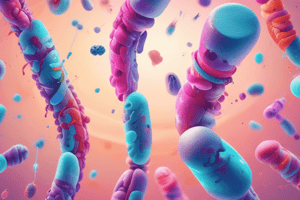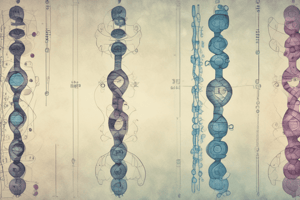Podcast
Questions and Answers
Which of the following best describes the primary purpose of a karyotype?
Which of the following best describes the primary purpose of a karyotype?
- To study the arrangement and structure of chromosomes. (correct)
- To analyze gene expression levels within a cell.
- To measure the rate of cell division.
- To identify specific protein interactions in the nucleus.
Karyotyping can be used to differentiate between chromosomes of the same species.
Karyotyping can be used to differentiate between chromosomes of the same species.
False (B)
During what phase of cell division are chromosomes typically observed for karyotyping?
During what phase of cell division are chromosomes typically observed for karyotyping?
metaphase
The karyotype is a representation of all of the ______ in a cell classified according to well-defined criteria.
The karyotype is a representation of all of the ______ in a cell classified according to well-defined criteria.
Match the following components with their role in understanding chromosomes
Match the following components with their role in understanding chromosomes
Cell renewal in living things is achieved through specialized cells. What is a crucial component within these cells that allows them to maintain their genetic characteristics during division and differentiation?
Cell renewal in living things is achieved through specialized cells. What is a crucial component within these cells that allows them to maintain their genetic characteristics during division and differentiation?
The karyotyping procedure involves preparing, arranging, and categorizing genes of a cell.
The karyotyping procedure involves preparing, arranging, and categorizing genes of a cell.
Karyotyping is a technique for ______ and studying chromosomes.
Karyotyping is a technique for ______ and studying chromosomes.
What is the immediate next step after taking microphotographs of metaphase chromosomes during karyotyping?
What is the immediate next step after taking microphotographs of metaphase chromosomes during karyotyping?
During karyotyping, chromosomes are arranged randomly without any specific criteria.
During karyotyping, chromosomes are arranged randomly without any specific criteria.
State two key criteria used to arrange chromosomes during the final step of karyotyping.
State two key criteria used to arrange chromosomes during the final step of karyotyping.
In a karyotype, the 22 pairs of ______ are numbered from 1 to 22.
In a karyotype, the 22 pairs of ______ are numbered from 1 to 22.
Match the following characteristics to the correct individual (A or B) based on their karyotype:
Match the following characteristics to the correct individual (A or B) based on their karyotype:
If a karyotype shows 44 autosomes and two X chromosomes, the individual is:
If a karyotype shows 44 autosomes and two X chromosomes, the individual is:
Individuals A and B have a different number of chromosomes.
Individuals A and B have a different number of chromosomes.
What sex chromosomes are present in individual B's karyotype?
What sex chromosomes are present in individual B's karyotype?
How does the presence of the Y chromosome in the karyotype of Mrs. X's fetus determine its sex?
How does the presence of the Y chromosome in the karyotype of Mrs. X's fetus determine its sex?
A normal human karyotype contains 47 chromosomes.
A normal human karyotype contains 47 chromosomes.
What specific chromosomal abnormality is identified in the karyotype of Mrs. X's fetus?
What specific chromosomal abnormality is identified in the karyotype of Mrs. X's fetus?
The karyotype can detect chromosomal ________, especially during prenatal diagnosis.
The karyotype can detect chromosomal ________, especially during prenatal diagnosis.
Match the following terms with their descriptions.
Match the following terms with their descriptions.
Why are human red blood cells unsuitable for karyotyping?
Why are human red blood cells unsuitable for karyotyping?
In karyotyping, cell culture is performed before cell collection.
In karyotyping, cell culture is performed before cell collection.
What is the purpose of using a hypotonic solution in karyotyping?
What is the purpose of using a hypotonic solution in karyotyping?
The purpose of staining chromosomes in karyotyping is to ______ the bands on the chromosomes.
The purpose of staining chromosomes in karyotyping is to ______ the bands on the chromosomes.
At which stage of cell division are chromosomes typically blocked for karyotyping?
At which stage of cell division are chromosomes typically blocked for karyotyping?
Which of the following best describes the primary goal of spreading chromosomes on a slide during karyotyping?
Which of the following best describes the primary goal of spreading chromosomes on a slide during karyotyping?
Microscopic observation in karyotyping is exclusively performed using traditional microscopes with cameras; computer screens are not used.
Microscopic observation in karyotyping is exclusively performed using traditional microscopes with cameras; computer screens are not used.
Match the following steps of karyotyping with their correct description:
Match the following steps of karyotyping with their correct description:
If two species have the same number of chromosomes, what is the most likely reason they are still different species?
If two species have the same number of chromosomes, what is the most likely reason they are still different species?
All species with 48 chromosomes are closely related.
All species with 48 chromosomes are closely related.
In karyotype preparation, what is the purpose of placing cells in a hypotonic solution?
In karyotype preparation, what is the purpose of placing cells in a hypotonic solution?
During amniocentesis, a ______ is performed to analyze the fetus's chromosomes.
During amniocentesis, a ______ is performed to analyze the fetus's chromosomes.
Match each species with its corresponding number of chromosomes:
Match each species with its corresponding number of chromosomes:
What is the primary purpose of performing amniocentesis when a potential issue is detected via ultrasound during pregnancy?
What is the primary purpose of performing amniocentesis when a potential issue is detected via ultrasound during pregnancy?
Staining chromosomes with a dye helps in visualizing them under a microscope.
Staining chromosomes with a dye helps in visualizing them under a microscope.
Why are cells blocked at metaphase during karyotype preparation?
Why are cells blocked at metaphase during karyotype preparation?
Flashcards
Karyotype
Karyotype
Representation of all chromosomes in a cell, classified by specific criteria.
Uses of Karyotype
Uses of Karyotype
Studying the number and structure of chromosomes; identifying abnormalities; differentiating chromosomes of different species.
Karyotyping Procedure
Karyotyping Procedure
A process of preparing, arranging, and categorizing chromosomes of a cell for analysis.
Karyotyping Observation
Karyotyping Observation
Signup and view all the flashcards
Karyotype Technique
Karyotype Technique
Signup and view all the flashcards
Cell Renewal
Cell Renewal
Signup and view all the flashcards
Chromosomes
Chromosomes
Signup and view all the flashcards
When to observe chromosomes for karyotyping
When to observe chromosomes for karyotyping
Signup and view all the flashcards
Karyotyping
Karyotyping
Signup and view all the flashcards
Cell Collection
Cell Collection
Signup and view all the flashcards
Why not red blood cells?
Why not red blood cells?
Signup and view all the flashcards
Cell Culture
Cell Culture
Signup and view all the flashcards
Metaphase Blocking
Metaphase Blocking
Signup and view all the flashcards
Hypotonic Solution
Hypotonic Solution
Signup and view all the flashcards
Spreading Chromosomes
Spreading Chromosomes
Signup and view all the flashcards
Staining
Staining
Signup and view all the flashcards
Microphotography (Karyotyping)
Microphotography (Karyotyping)
Signup and view all the flashcards
Chromosome Arrangement (Karyotyping)
Chromosome Arrangement (Karyotyping)
Signup and view all the flashcards
Criteria for Chromosome Arrangement
Criteria for Chromosome Arrangement
Signup and view all the flashcards
Autosomes
Autosomes
Signup and view all the flashcards
Sex Determination via Karyotype
Sex Determination via Karyotype
Signup and view all the flashcards
Sex Chromosomes (Gonosomes)
Sex Chromosomes (Gonosomes)
Signup and view all the flashcards
Normal vs. Abnormal Karyotype
Normal vs. Abnormal Karyotype
Signup and view all the flashcards
Importance of Karyotyping
Importance of Karyotyping
Signup and view all the flashcards
Female Sex Chromosomes
Female Sex Chromosomes
Signup and view all the flashcards
Trisomy 21
Trisomy 21
Signup and view all the flashcards
Male Sex Chromosomes
Male Sex Chromosomes
Signup and view all the flashcards
Karyotype Result: Abnormal
Karyotype Result: Abnormal
Signup and view all the flashcards
Chromosome Number
Chromosome Number
Signup and view all the flashcards
Same #, Different Species
Same #, Different Species
Signup and view all the flashcards
Genetic Information Variation
Genetic Information Variation
Signup and view all the flashcards
Amniocentesis
Amniocentesis
Signup and view all the flashcards
Karyotype Preparation
Karyotype Preparation
Signup and view all the flashcards
Hypotonic Solution (Karyotyping)
Hypotonic Solution (Karyotyping)
Signup and view all the flashcards
Chromosome Staining
Chromosome Staining
Signup and view all the flashcards
Metaphase Arrest (Karyotyping)
Metaphase Arrest (Karyotyping)
Signup and view all the flashcards
Study Notes
- Karyotypes are representations of all the chromosomes in a cell classified by established criteria.
- Karyotypes can show number and structure to identify abnormalities and differentiate chromosomes across species.
- Karyotyping involves preparing, arranging, and categorizing chromosomes observed during cell division.
Steps of Karyotyping Procedure
- Step 1: Cell Collection
- Collect a blood sample to obtain nucleated white blood cells.
- Nucleated cells can come from bone marrow, amniotic fluid, or placenta.
- Red blood cells are unsuitable because they lack a nucleus and chromosomes.
- Step 2: Cell Culture
- White blood cells removed from the blood are grown and multiplied in a culture medium.
- Step 3: Metaphase Blocking
- A chemical called Colchicine is used to lock the chromosomes into Metaphase, for better visibility.
- Step 4: Hypotonic Solution
- Cells blocked at metaphase are placed in a hypotonic solution so they swell, burst, and spread out their chromosomes.
- Step 5: Spreading the Chromosomes
- Cellular components/chromosomes are placed on glass so that clusters are easier to see
- Step 6: Staining
- The preparation is fixed and stained to visualize chromosome bands.
- Step 7: Microscopic Observation
- The preparation is viewed with a camera-equipped microscope or directly on a computer screen.
- Step 8: Microphotography
- Pictures are taken of the chromosomes locked at metaphase.
- Step 9: Cutting Out and Arrangement
- The chromosome photograph is cut up and arranged by well-defined criteria.
Chromosome Arrangement Criteria
- Chromosomes are arranged in homologous pairs with the same size, centromere position and same banding pattern.
- Chromosomes are arranged decreasing in size
- 22 pairs of autosomes (non-sex chromosomes) are numbered 1 to 22.
- The 23rd pair of the sex chromosomes, or gonosomes, are set aside from autosomes.
Sex Chromosome Determination
- Both male and female karyotypes contain 46 chromosomes or, 23 pairs of chromosomes.
- This includes 44 autosomes or, 22 pairs of homologous autosomes.
- Females possess 44 autosomes + XX sex chromosomes.
- Males possess 44 autosomes + XY sex chromosomes
- Individual A with XX chromosomes is female, while individual B with Y chromosome is male.
Chromosome Number in Species
- The number of chromosomes generally characterizes a species.
- Different species may have the same chromosome quantity, but are different.
- E.g. Mice have 40 chromosomes and peas have 14 chromosomes.
- E.g Rats have 42 chromosomes and onions have 16 chromosomes.
- E.g Monkeys have 42 chromosomes and corn has 20 chromosomes.
- E.g. Men have 46 and tomatoes have 24 chromosomes.
- E.g. Chimpanzees have 48 and rice has 24 chromosomes.
Chromosome Number in Some Species
- The number of chromosomes is generally characteristic of the species.
- Some species may have the same number of chromosomes, but the information is not the same.
- E.g. Dogs have 78 chromosomes and tobacco has 48 chromosomes.
- E.g. Hens have 78 chromosomes and potatoes have 48 chromosomes.
End of Lesson Questions
- An ultrasound of a Mrs X at her 16th week pregnancy and an ultrasound had detected that the thickness of the neck of her fetus is not normal so he prescribed an amniocentesis to perform the karyotype of the fetus.
Document 1 shows the steps of karyotype preparation.
-
Missing Steps
- Cells blocked at metaphase are put in hypotonic solution.
- Chromosomes are stained with a dye. Document 2 represents the karyotype of the fetus of Mrs. X.
-
Specify the sex of the fetus.
- The fetus is male since his karyotype reveals the presence of the gonosome Y.
-
Verify if the karyotype of the fetus is normal or not.
- The karyotype of the fetus is not normal because it shows the presence of 47 chromosomes instead of 46 including one extra chromosome n°21 ( three chromosomes 21 instead of two)
-
In addition to its role in the identification and differentiation of chromosomes in different species, the karyotype can detect chromosomal abnormalities, especially during prenatal diagnosis.
Studying That Suits You
Use AI to generate personalized quizzes and flashcards to suit your learning preferences.



